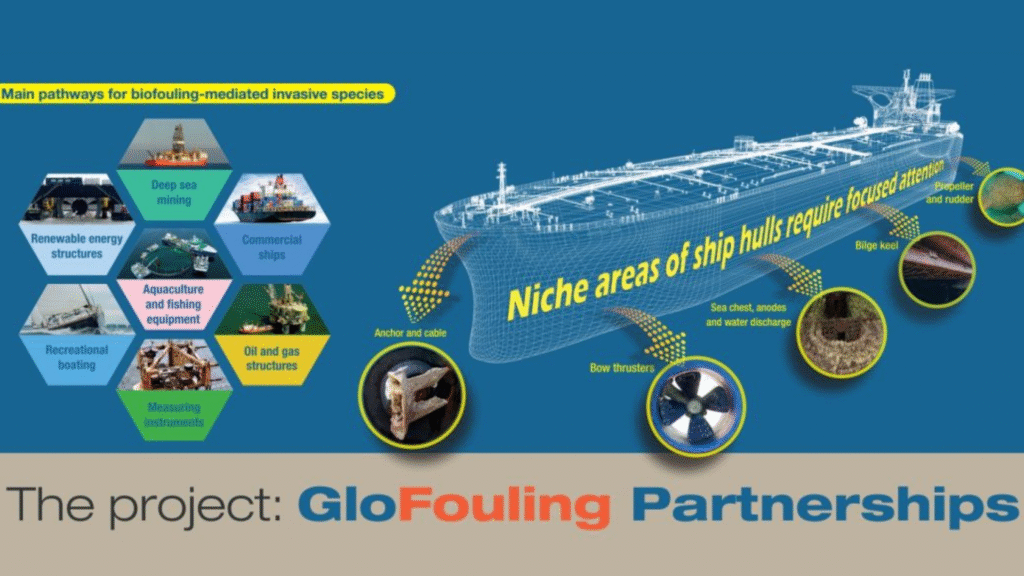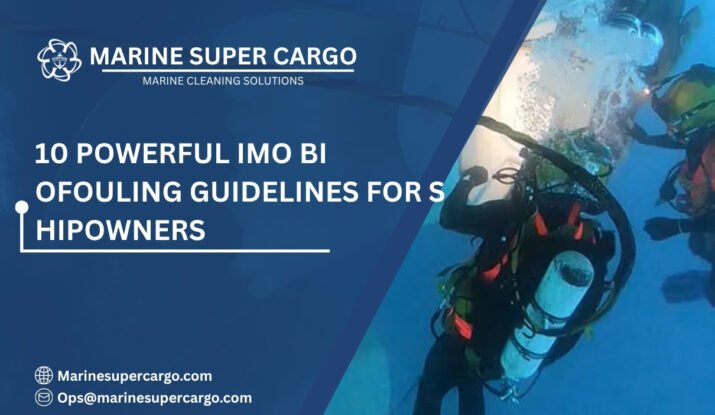Shipping has always been the backbone of global trade. But with this power comes responsibility: to move goods without harming the oceans that sustain us. Among the many challenges shipowners face today, biofouling stands out.
It looks like a simple coating of slime or barnacles, but in reality, it’s a silent threat to compliance, efficiency, and ecosystems. To manage this, the International Maritime Organization (IMO) introduced a framework of best practices known widely as the IMO biofouling guidelines.
Picture your vessel’s hull as the smooth surface of a race car. Over time, if mud and weeds stick to it, the car struggles to maintain speed and wastes fuel. That’s exactly what biofouling does to a ship. And just like racing comes with rules, international shipping follows strict IMO guidelines to keep these impacts under control.
In this long-form article, we’ll break down 10 essential IMO biofouling guidelines, why they matter, and how they can shape safer, more cost-effective ship operations for you.
What is Biofouling?
Biofouling refers to the accumulation of aquatic organisms—algae, barnacles, mussels, bacteria, seaweed—on a ship’s submerged surfaces, especially the hull. It starts small with microfouling (a thin slime layer) but soon grows into macrofouling, where hard shells and large organisms attach, adding significant drag.
Why is it a problem?
- It slows down ships, forcing engines to work harder.
- It raises fuel consumption by 10–40%.
- It increases greenhouse gas emissions, undermining IMO decarbonization targets.
- It spreads invasive species between ports, threatening biodiversity.
This is why understanding IMO biofouling management is now unavoidable for modern fleets.

Why IMO Issued Biofouling Guidelines
The IMO realized that without a global standard, vessel operators might clean hulls inconsistently or unsafely. This could lead either to inefficient ships or damaging discharges during cleaning. Thus, IMO biofouling guidelines were published to encourage the adoption of best practices across all fleets.
The goals:
- Minimize invasive species transfer.
- Improve fuel efficiency and reduce emissions.
- Provide uniform compliance tools for shipowners and managers.
- Promote environmental stewardship in global shipping.
Read also about underwater hull cleaning in the UAE
Vanuatu and Tonga advance maritime safety with oil spill drills, training.
— International Maritime Organization (@IMOHQ) August 14, 2025
Read the full story here: https://t.co/URtguS1cLi #OilSpillResponse #MaritimeSafety pic.twitter.com/caRLJ8EL9J
10 Essential IMO Biofouling Guidelines
Let’s explore the 10 pillars of IMO’s recommendations, designed to turn biofouling challenges into manageable, compliance-ready processes.
1. Develop a Biofouling Management Plan
Every vessel should maintain a ship-specific plan that includes:
- How the vessel will monitor fouling.
- When and where hull cleanings will take place.
- Recordkeeping practices.
This ensures biofouling management is systematic, not just reactive.
2. Carry a Biofouling Record Book
Documentation is key for compliance. A record book should capture inspection dates, cleaning actions, and waste disposal methods. Many port authorities now check this during inspections, reinforcing IMO biofouling compliance.
3. Optimize Hull Design and Coatings
Ships should use antifouling or foul-release coatings that reduce organism settlement. Smooth, advanced coatings reduce drag and prolong intervals between cleanings.
4. Implement Regular Inspections
Visual inspections, especially during port stays, are essential to detect fouling early. Both divers and remotely operated vehicles (ROVs) are used today. Catching macrofouling early is cheaper and easier than large-scale cleaning later.
5. Proactive In-Water Cleaning
Instead of waiting for significant drag to develop, scheduled in-water cleaning keeps hulls efficient. However, waste collection systems are critical. Without waste capture, cleaning might breach MARPOL Annex V under environmental discharge rules.
6. Manage Niche Areas Effectively
Propellers, gratings, sea chests, rudders, and thruster tunnels are hotspots for fouling. Biofouling in these “niche areas” can be even more damaging than flat hull surfaces because it affects maneuverability. IMO emphasizes their inspection in all biofouling guidelines.
7. Avoid Risky Ballast Water Practices
While ballast water has its own management convention, biological material from niches and hull fouling can transfer invasive organisms. Combined practices reduce risks.
8. Port and Coastal Sensitivity Awareness
Not all waters are the same. Warmer, nutrient-rich environments accelerate fouling. Ship operators must track high-risk zones and plan biofouling management accordingly, in line with IMO recommendations.
9. Follow MARPOL Annex V for Waste
Hull cleaning generates waste, including organisms and coating fragments. These fall under waste discharge laws regulated by MARPOL Annex V. Following the IMO biofouling guidance ensures that waste is collected and disposed of responsibly.
10. Crew Training and Awareness
A plan is only as strong as the people implementing it. IMO recommends training crews in spotting, recording, and reporting fouling so decisions can be made promptly and correctly.
How IMO Biofouling Links to Compliance
The IMO biofouling guidelines connect with several other regulations:
- MARPOL Annex V: Regulates cleaning waste disposal.
- IMO’s CII and EEXI: A fouled hull hurts efficiency and ratings.
- IAPH Port Guidelines: Ports require cleaning and debris capture.
- IMCA Codes: Reinforce diver and ROV cleaning standards.
Thus, compliance is multi-layered but unified under the IMO’s framework.
Fuel Efficiency Benefits
Fouled hulls waste billions in extra fuel every year. IMO research estimates:
- Microfouling raises fuel costs 10–15%.
- Heavy macrofouling pushes consumption 30–40% higher.
By embracing IMO biofouling best practices, operators save drastically on fuel while protecting the environment and avoiding penalties.
Environmental Relevance
The IMO biofouling framework is as much about biodiversity as compliance. Without proper management, invasive species cling to vessels and travel thousands of miles to new ecosystems, displacing native organisms and damaging fisheries.
Preventing this through better hull cleaning practices protects marine ecosystems and demonstrates operator responsibility.
Innovations in Hull Biofouling Control
The future looks promising with new tools inspired by IMO guidelines:
- Robotic Cleaning Systems with underwater waste collection.
- Biomimetic Coatings inspired by shark skin and lotus leaves.
- AI Monitoring Tools are predicting growth levels based on temperature and salinity.
- Eco-Friendly Nanocoatings reduce toxic leaching from antifouling paints.
Adopting these innovations aligns fleets with IMO biofouling strategies and strengthens regulatory compliance.

Challenges in Implementation
Of course, compliance isn’t without hurdles:
- Costs of coating, underwater cleaning, and recordkeeping rise upfront.
- Inspections disrupt schedules.
- Differences in port regulations may confuse operators.
But ignoring IMO biofouling can cost significantly more in fuel waste, penalties, and reputational damage. Compliance is an investment, not an expense.
From the Montreal Protocol on Ozone to the Paris Agreement on climate, and to the Minamata Convention on mercury, multilateral agreements unite countries to protect people and planet.
— UN Environment Programme (@UNEP) August 13, 2025
Now, #INC5 aims to add another milestone: a #PlasticsTreaty.
Explore more:… pic.twitter.com/aCS45SaH7X
Conclusion
IMO’s work on biofouling has laid a path for cleaner and greener shipping. To recap:
- IMO biofouling guidelines help reduce invasive species and fuel consumption.
- They link directly with MARPOL Annex V, IMO CII, and IAPH port protocols.
- Proactive compliance isn’t just regulatory—it saves costs and enhances reputation.
To keep your ships compliant, efficient, and environmentally responsible, engage with solutions that support sustainable hull cleaning practices. Explore practical expertise at CleanShip.co to move ahead with confidence in the IMO era.
FAQ:
Q1. What are IMO biofouling guidelines?
They are international best practices developed by IMO for managing hull fouling, preventing invasive species spread, saving fuel, and reducing emissions across global fleets.
Q2. How does biofouling affect fuel efficiency?
By increasing surface drag, biofouling forces ships to burn 10–40% more fuel. Compliance with IMO biofouling practices keeps hulls clean and efficiency strong.
Q3. Is hull cleaning waste regulated?
Yes. Waste from hull cleaning (slime, organisms, paint flakes) is controlled under MARPOL Annex V, linking to IMO biofouling practices that require disposal controls
Q4. What role does technology play in biofouling management?
New tools like robotic cleaners, AI fouling monitors, and eco-friendly coatings make compliance cheaper, safer, and more efficient under IMO biofouling rules.
Q5. Why should operators adopt IMO biofouling guidelines now?
Because waiting increases costs and risks. Compliance saves fuel, ensures regulatory readiness, and protects your fleet’s reputation globally.


